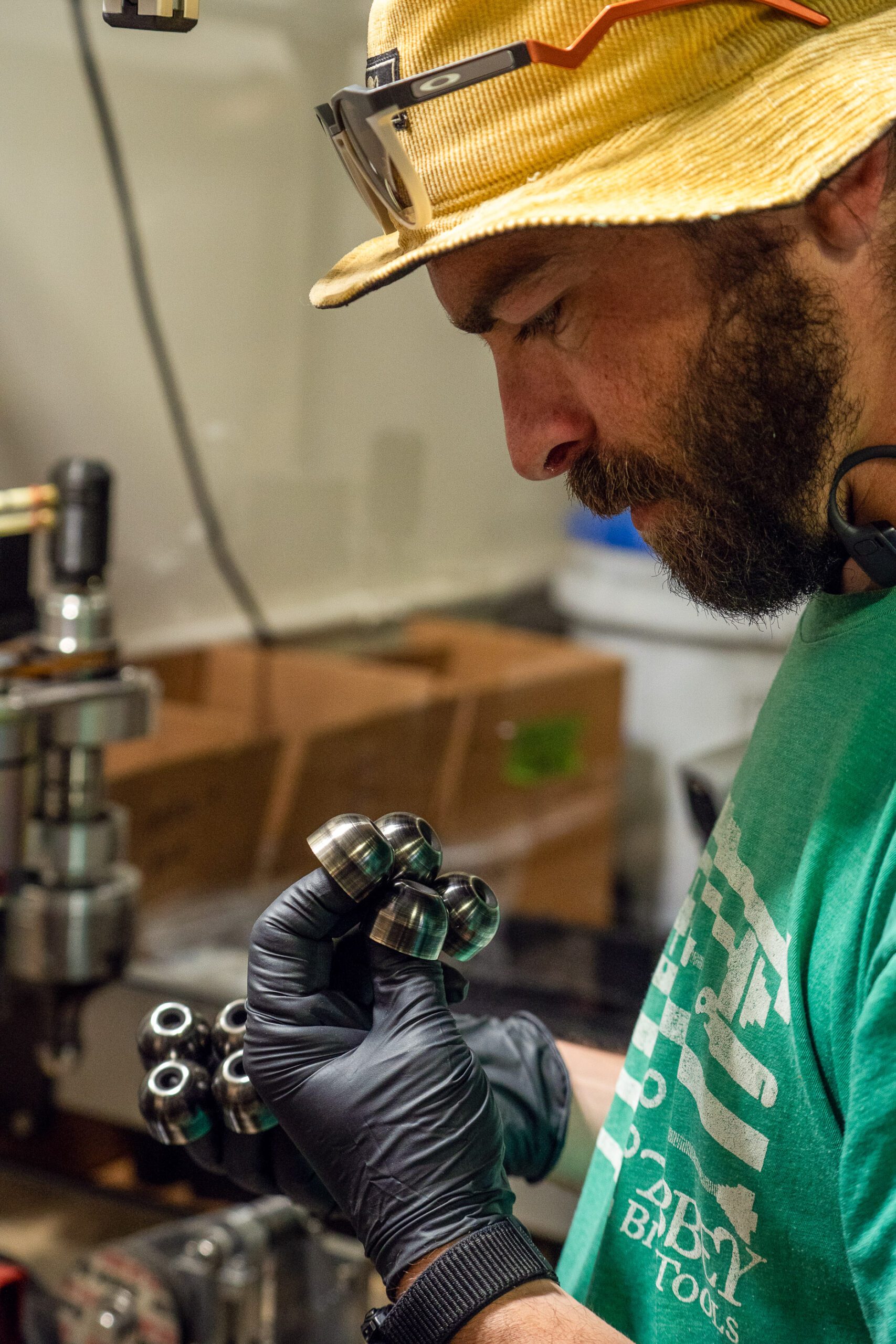Simple on the surface, the Spurcycle bell is a product of about a dozen distinct parts. “They all require different types of manufacturing,” says Nick. “The dome is formed on a big deep-draw press machine. There are some stamped parts – the mount and the nut on the inside of the bell. We’ve got some rubber injection molded parts. The hammer is a turned CNC part.” If they were manufacturing in Asia, Nick and Clint would have an agent, a single point of contact who could liaise with each component maker in turn. Not so, in the US. “There’s a lot less of that sort of relationship here,” he says. “We had to go out and find each part maker. For example, our wireform is coming out of Ohio, for coatings, we go to the East Coast and California, our dome, as we talked about, is made in New Mexico.” Nick paints a picture of parts pinging their way across the States, before returning piece by piece to the brand’s HQ in Bend, Oregon, where each bell is hand-assembled and tested.
“To be frank, we didn’t expect to be still making our bells in this manner,” admits Nick. “The reality is, though, that there’s no other way we’ve found to make them the way we want them, with the level of quality we demand.” In related US news, fans of the brand’s key clip will be pleased to hear that soon, Spurcycle’s production partner, Paragon Machine Works, will spin up its tools to produce version two of what we can attest is the finest key clip we’ve ever used. “It’s another example of a product where it makes sense to manufacture it here in the US,” Nick says. However, the brand’s multi-tool, which Nick also informs us is now back to production, fabricated in Taiwan, a practical decision, he says, predicated on the nature of the product and the low minimums a partner can reliably expect to commit to while guaranteeing the extremely tight tolerances Spurcycle demands.
Nick then tells us a story that takes us back to the beginning, to the Kickstarter that launched their business, a story that aptly illustrates the brand’s unwavering focus on quality and why production is not an email-and-forget process. “We initially found a company that made bells and could form our dome,” he says. “You can’t machine a dome and have it sound the same as if it’s formed. We’d machined some, and they didn’t sound great, but luckily, this company found a tool in their facility that could form our dome. That one step saved us tens of thousands of dollars, allowing us to meet our Kickstarter obligations and fulfil our production runs for the first two years of the business. However, they were a very old-school company – they’d been around for over 100 years. So when we started to drive for improvements in certain areas to enhance quality, such as refining the brushing technique to be a little more radial and developing a specification around the coarseness and consistency of the brush, they pushed back and told us, ‘Hey, we’re not making jewellery.’ To which we replied that, actually, we are; this is bicycle jewellery, a bell that costs five times more than most bells on the market. We have to hit that spec.” A move to a new partner followed, one more accustomed to finer tolerances and more willing to work with Spurcycle to realize its dream of making the world’s most beautiful – and everything else – bicycle bells.
We can all picture a bike bell in our minds in the same way we can picture a bike; it’s an imprinted form that cyclists the world over could sketch out in a second, a circle with a little lever on the side. Did Nick ever worry that Spurcyle’s design was too much bell for the bike business? Too different? Nick muses for a moment. “That’s a great question,” he says. “To be truthful, sometimes you’re not quite sure how your success came to be. We started this business because we couldn’t find a bicycle bell that we wanted to put on our bikes. We were both living in San Francisco at that time, and the Golden Gate Bridge was a regular on our rides when we’d head out of the city towards Marin and the Headlands. There’s a multi-use path over the bridge, and man, that’s a stretch that cries out for a bell. So my brother and I started experimenting with ideas. We knew it would have to be smaller than other models to align with the aesthetic of our bikes. It also had to mount on a 31.8 handlebar and be able to be tipped forward so it didn’t meet the wind and sit behind the bar. Anyway, we’d been working with a friend who was a pretty talented industrial designer, and he came up with the novel concept that the wire lever would be an offset spring and the thing your finger interacts with for actuation.
“We worked on the look, shape, and size constraints, but ultimately, people liked it. When we did the Kickstarter, we didn’t have a fully fledged design ready to go. We were maybe at 80%. Anyway, we went live and thought we’d see a few units move, but it went crazy. We set a $50,000 goal, which was quickly met. Within a week, we exceeded $100,000. Ultimately, we had 6,000 backers and raised over $300k.” Within thirty days, Nick and Clint had gone from an idea to having 10,000 bells to make.
“At that scale, we couldn’t ship a beta product. We had to finish development and do it right,” he says. “The success of Kickstarter forced us to move fast. So we both quit our jobs and never looked back.” Years later, though, Spurcycle’s bell still stands alone. There have been imitators, flagrant copies, but never anything to match it. “The industry evolves and there are trends,” says Nick. “But with our bell, some things came our way and we stayed the course.” This is no false modesty. Nick gives every impression of being as careful with his words as he is with Spurcycle’s SKU count. So we’ll say what he should have: the Spurcycle bell is an icon. Nick and Clint nailed it, and they had the good sense to follow up their design and early success with clarity and the wisdom to eschew the funding that could so easily have robbed them of the potency of their singular approach.
Will we see Spurcycle ringing the changes in the future? “We’re not resistant to change and expect to evolve,” he says. “The distinction is that we will remain intentionally focused. Right now, we’re most excited and determined to ‘undork’ mirrors. Much like we did with bells, we hope to put an industry spotlight on an overlooked but important cycling accessory that could be much more.”
For now, though, while Spurcycle looks back to the future, if you haven’t had the pleasure of flicking the wire loop of a Spurcycle bell and hearing its strident ding, we recommend you do so at your first opportunity.
Regroup is a proud Spurcycle stockist.

